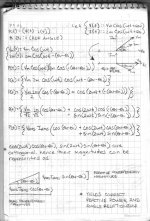A challenge for the electrical engineers…
From a physics standpoint the only true concept behind electrical power is the instantaneous power p(t) = v(t)•i(t). Real, Reactive and Apparent power are made up engineering concepts…
Given this fact, how many of you have actually questioned where the “power triangle” came from and it’s connection to physics? Do you understand this relationship and more importantly how it came to be? Why are the components in quadrature? What does this even mean in terms of instantaneous power? Can you provide a derivation or rigorous proof of its validity and use? If not, can you truly consider yourself an electrical engineer?
Have fun… the results may surprise you.
Start with the general equation of a sine wave:
y = A*sin(w*t + phi) + D
where:
A is amplitude
w is the radian frequency, traditionally represented with an omega, but I'll type w for simplicity.
phi is the phase offset
D is the offset of the midline of the sine wave from zero
For pure AC, the value of the DC offset (D) is by definition equal to zero:
y = A*sin(w*t + phi)
Using the trig identity, this sine term can be re-written as a combination of sine and cosine:
sin(alpha + beta) = sin(alpha)*cos(beta) + cos(alpha)*sin(beta)
Since beta in our previous equation is a constant (i.e. phi, the phase offset), we can write y as a sum of sine and cosine waves:
y = a*sin(w*t) + b*cos(w*t)
Lowercase a and b become the coefficients of sine and cosine of the w*t input, and are both functions of the overall amplitude (A), and the phase.
a = A*cos(phi)
b = A*sin(phi)
Now we will make V(t) and I(t) equal to variants of this equation. They will both be AC waveforms with two independent parameters, that ultimately determine the phase and amplitude. The difference is that these are instead written as coefficients of sine and cosine, instead of phase and amplitude.
V(t) = Va*sin(w*t) + Vb*cos(w*t)
I(t) = Ia*sin(w*t) + Ib*cos(w*t)
When V(t) and I(t) are represented as vectors, the values Va, Vb, Ia, and Ib become the components of these vectors, indicating the amplitudes of the sine and cosine components of their waveforms. <Va, Vb> is the vector of voltage, and <Ia, Ib> is the vector of current.
It is arbitrary where time is defined to zero. For simplicity, choose the time origin, such that the voltage waveform is the sine wave. This means Vb is by definition equal to zero.
V(t) = Va*sin(w*t)
I(t) = Ia*sin(w*t) + Ib*cos(w*t)
Multiply them together to get instantaneous power:
P(t) = V(t)*I(t)
P(t) = Va*sin(w*t)*(Ia*sin(w*t) + Ib*cos(w*t))
P(t) = Va*Ia*sin^2(w*t) + Va*Ib*sin(w*t)*cos(w*t)
Use trig identities to replace sin^2 and the product of sine and cosine:
sin^2(w*t) = 1/2*(1 - cos(2*w*t))
sin(w*t)*cos(w*t) = sin(2*w*t)/2
We are ultimately interested in the average value of the power of time function. If it adds up to zero over a cycle, it doesn't contribute any net power. It indicates storage and discharge of power in components such as capacitors and inductors, that just offset the phase. If power accumulates over the course of time with this function, then this means it contributes to real power. One cycle is called the period, and is equal to 2*pi/w.
integral of 1/2*(1 - cos(2*w*t)), from 0 to 2*pi/w =
1/2* (integral of 1, from 0 to 2*pi/w - integral of cos(2*w*t), from 0 to 2*pi/w)
1/2*(2*pi/w) - integral of cos(2*w*t), from 0 to 2*pi/w)
pi/w - integral of cos(2*w*t), from 0 to 2*pi/w)
pi/w - (sin(2*w*(2*pi/w)) - sin(0)))
pi/w - (sin(4*pi) - sin(0)))
pi/w
When taking an average value of the function, we have to divide by the total interval of integration.
avg of sin^2(w*t) = (pi/w) / (2*pi/w)
avg of sin^2(w*t) =1/2
integral of sin(2*w*t)/2 from 0 to 2*pi/w =
1/2*(-cos(2*w*(2*pi/w) - - cos(0))
1/2*(-cos(4*pi) - - cos(0))
1/2*(-1 + 1)
0
As you can see, only the sin^2(w*t) has a nonzero average value. Therefore, the average power is given by
Pavg = Va*Ia/2
What exactly do we do about the 1/2? That's where RMS voltage and current come in to play, and this is why it is the square root of 2 between RMS amplitudes and actual amplitudes. Va = sqrt(2) * Vrms. Ia = sqrt(2) * Ia_rms. Ib = sqrt(2) * Ib_rms. When multiplying together the square roots of 2, we take care of this 1/2 factor, such that Pavg = Vrms * Ia_rms. Since we represent I as a vector sum of Ia and Ib, this means that I = sqrt(Ia^2 + Ib^2), or in terms of rms currents, I = sqrt(2)*sqrt(Ia_rms^2 + Ib_rms^2). Make an overall RMS value for I, which is I = Irms*sqrt(2). This means Irms = sqrt(Ia_rms^2 + Ib_rms^2)
This shows that Ib, the component of the current waveform that is orthogonal to the voltage waveform, contributes NOTHING to the average real power delivered by the source to the load. The component current waveform that is orthogonal to the voltage waveform contributes to the mathematical contstruct we call reactive power.
Real Power:
P = Vrms * Ia_rms
Reactive power:
Q = Vrms * Ib_rms
Total apparent power:
S = Vrms * Irms
S = Vrms * sqrt(Ia_rms^2 + Ib_rms^2)
This shows how the cosine component of current, relative to voltage being exclusively a sine wave, allows us to represent real power (Watts) and reactive power (VA reactive) as perpendicular components of the power triangle. And the hypotenuse as the apparent power (VA).


